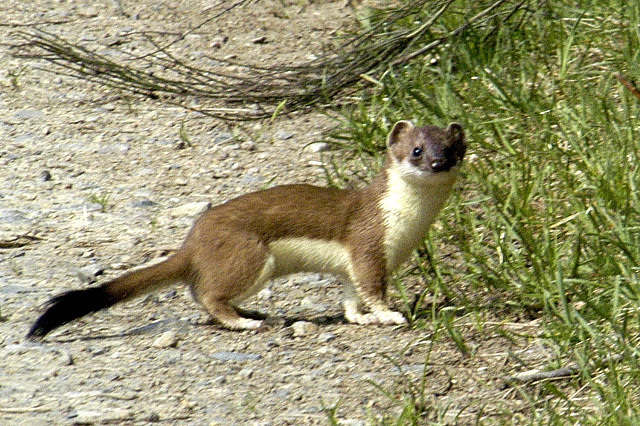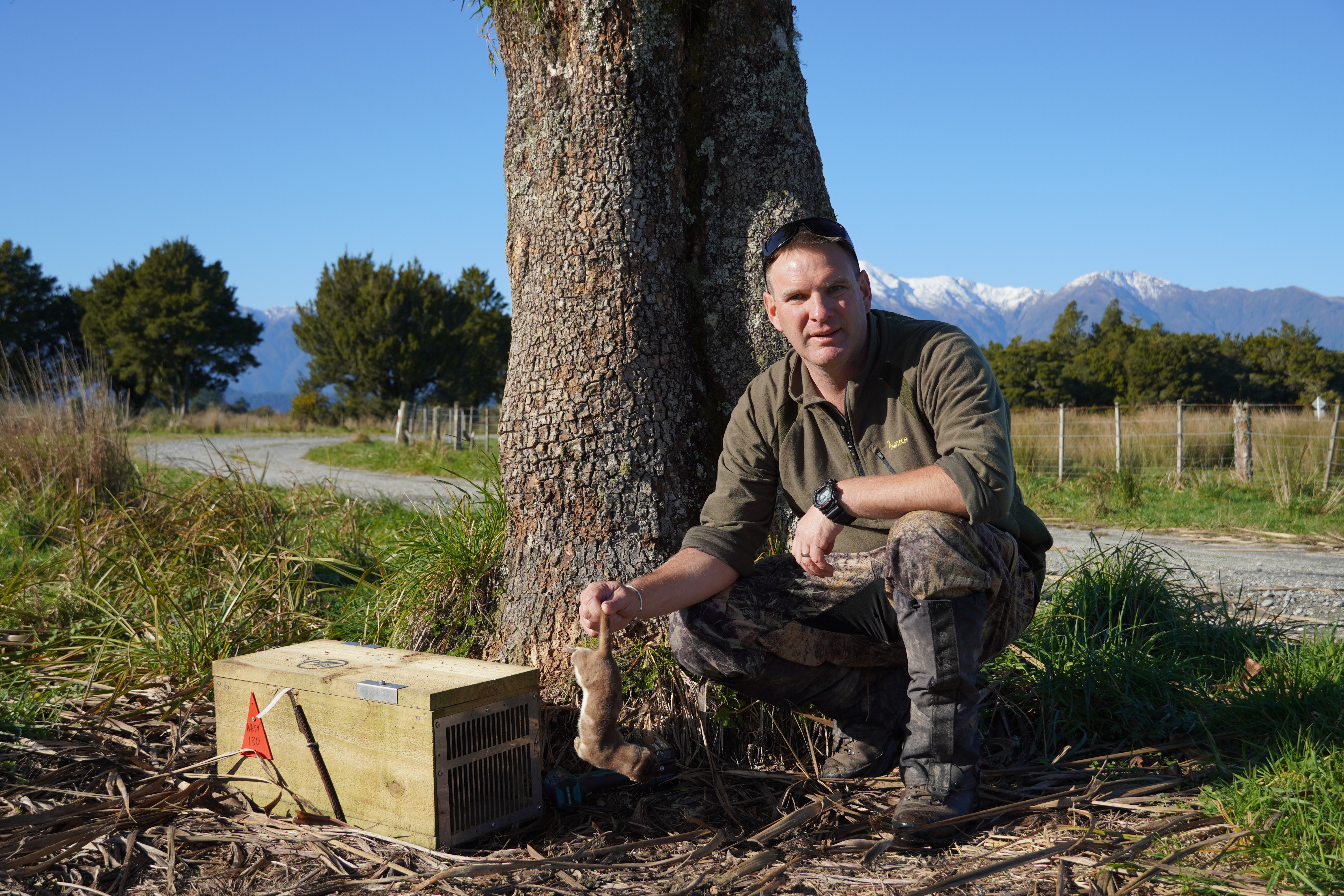Stoat in New Zealand on:
[Wikipedia]
[Google]
[Amazon]
 The
The 

 In addition to birds, stoats eat insects,
In addition to birds, stoats eat insects,
Stoats
at the Department of Conservation
Ferret and Stoat Research
{{Webarchive, url=https://web.archive.org/web/20110614143354/http://www.landcareresearch.co.nz/research/wildlifeecol/ferrets/index.asp , date=2011-06-14 at Landcare Research
Stoats and cats
at Te Ara: The Encyclopedia of New Zealand *
Death unleashed
, Otago Daily Times, 24 January 2022 Nature conservation in New Zealand Invasive animal species in New Zealand Invasive mammal species Mammals of New Zealand
 The
The stoat
The stoat (''Mustela erminea''), also known as the Eurasian ermine or ermine, is a species of mustelid native to Eurasia and the northern regions of North America. Because of its wide circumpolar distribution, it is listed as Least Concern on th ...
(''Mustela erminea'') was introduced into New Zealand to control introduced rabbit
Rabbits are small mammals in the family Leporidae (which also includes the hares), which is in the order Lagomorpha (which also includes pikas). They are familiar throughout the world as a small herbivore, a prey animal, a domesticated ...
s and hare
Hares and jackrabbits are mammals belonging to the genus ''Lepus''. They are herbivores and live Solitary animal, solitarily or in pairs. They nest in slight depressions called forms, and their young are precociality, able to fend for themselves ...
s, but is now a major threat to the native bird population. The natural range of the stoat is limited to parts of the Northern Hemisphere
The Northern Hemisphere is the half of Earth that is north of the equator. For other planets in the Solar System, north is defined by humans as being in the same celestial sphere, celestial hemisphere relative to the invariable plane of the Solar ...
. Immediately before human settlement, New Zealand did not have any land-based mammal
A mammal () is a vertebrate animal of the Class (biology), class Mammalia (). Mammals are characterised by the presence of milk-producing mammary glands for feeding their young, a broad neocortex region of the brain, fur or hair, and three ...
s apart from bat
Bats are flying mammals of the order Chiroptera (). With their forelimbs adapted as wings, they are the only mammals capable of true and sustained flight. Bats are more agile in flight than most birds, flying with their very long spread-out ...
s, but Polynesian and European settlers introduced a wide variety of animals. Rarely, in Southland, the fur of stoats has been reported to turn white, being the fur known as ermine, which adorns royal robes.


Introductions of stoats
The rabbit was introduced by European settlers as a food and game animal, and by the 1870s it was becoming a serious threat to the newly developed farming economy. Farmers began demanding the introduction of mustelids (including stoats) to control the rabbit plague. Warnings about the dangers to bird life from stoats were given by scientists in New Zealand andBritain
Britain most often refers to:
* Great Britain, a large island comprising the countries of England, Scotland and Wales
* The United Kingdom of Great Britain and Northern Ireland, a sovereign state in Europe comprising Great Britain and the north-eas ...
, including the New Zealand ornithologist Walter Buller
Sir Walter Lawry Buller (9 October 1838 – 19 July 1906) was a New Zealand lawyer and naturalist who was a dominant figure in New Zealand ornithology. His book, ''A History of the Birds of New Zealand'', first published in 1873, was published ...
. The warnings were ignored and stoats began to be introduced from Britain in the 1880s. Within six years, drastic declines in bird populations were noticed.
By 1930 the Auckland Acclimatisation Society was campaigning to end the protection of mustelids and cats.
The translocation efforts of New Zealand's pioneering conservationist Richard Henry were undone when stoats swam to Resolution Island. Stoats were eradicated from Chalky Island and other Fiordland
Fiordland (, "The Pit of Tattooing", and also translated as "the Shadowlands"), is a non-administrative geographical region of New Zealand in the south-western corner of the South Island, comprising the western third of Southland. Most of F ...
islands in the early 2000s, and scientists assumed that they would be unable to cross a 300 m water barrier, but stoats turned out to be able to reinvade: DNA testing confirmed that stoats regularly swim towards islands in summer, especially in beech
Beech (genus ''Fagus'') is a genus of deciduous trees in the family Fagaceae, native to subtropical (accessory forest element) and temperate (as dominant element of Mesophyte, mesophytic forests) Eurasia and North America. There are 14 accepted ...
mast years, and prefer long coastlines. In December 2010, a stoat was seen on what was thought to be the stoat-free Kapiti Island
Kapiti Island (), sometimes written as Kāpiti Island, is an island nature reserve located off the west coast of the lower North Island of New Zealand and within the Kāpiti Coast District. Parts of the island were previously farmed, but it is ...
, and by August the next year the New Zealand Department of Conservation had managed to remove three. It seems unlikely that a stoat could cross the five-kilometre stretch of open sea from the Kapiti Coast but they are accomplished swimmers: in an experiment in a flume tank, a stoat paddled against a moderate current for two hours without stopping, the equivalent of swimming 1.8 km.
Threat to bird life
New Zealand has a high proportion of ground-nesting and flightless birds, due to its long geographical isolation and a lack of mammal predators. Native birds have evolved to fill niches that are occupied by mammals in most other places. Stoats are the greatest threat to these ground-nesting and hole-nesting birds, which have very limited means of escaping stoat predation. In some areas the whio population is now 70% male, from stoats attacking female ducks incubating eggs. In addition to birds, stoats eat insects,
In addition to birds, stoats eat insects, mice
A mouse (: mice) is a small rodent. Characteristically, mice are known to have a pointed snout, small rounded ears, a body-length scaly tail, and a high breeding rate. The best known mouse species is the common house mouse (''Mus musculus' ...
and rat
Rats are various medium-sized, long-tailed rodents. Species of rats are found throughout the order Rodentia, but stereotypical rats are found in the genus ''Rattus''. Other rat genera include '' Neotoma'' (pack rats), '' Bandicota'' (bandicoo ...
s. During "beech masts", when southern beech trees (''Nothofagus
''Nothofagus'', also known as the southern beeches, is a genus of 43 species of trees and shrubs native to the Southern Hemisphere, found across southern South America (Chile, Argentina) and east and southeast Australia, New Zealand, New Guin ...
'' species) produce a far greater amount of seed than normal, the stoat population undergoes changes in predation behaviour. With high beech-seed numbers, rats and mice become more plentiful, and the increase in prey encourages stoat breeding. The higher stoat numbers reduce the rodent
Rodents (from Latin , 'to gnaw') are mammals of the Order (biology), order Rodentia ( ), which are characterized by a single pair of continuously growing incisors in each of the upper and Mandible, lower jaws. About 40% of all mammal specie ...
population and the stoats then prey on birds. For instance, the wild population of the endangered takahē
The South Island takahē (''Porphyrio hochstetteri'') is a Flightless bird, flightless swamphen indigenous to New Zealand and the largest living member of the Rail (bird), rail family. It is often known by the abbreviated name takahē, whic ...
dropped by a third between 2006 and 2007, after a stoat plague triggered by the 2005–2006 mast wiped out more than half the takahē in areas where stoat numbers were not limited by trapping.
Control measures
Stoats are difficult to control since they are bait-shy, trap-wary, and have highfecundity
Fecundity is defined in two ways; in human demography, it is the potential for reproduction of a recorded population as opposed to a sole organism, while in population biology, it is considered similar to fertility, the capability to produc ...
. In some areas where there are populations of endangered birds, a programme of stoat-trapping has been implemented. The most common method of trapping is to use a stoat tunnel – a wooden box with a small entrance at one end to allow the stoat to enter. The bait is often an egg and a trap is placed in the tunnel to kill the stoat. Recent trials of a new design of self-resetting stoat traps for remote areas have been encouraging.
"Mainland Islands", protected areas on the mainland of New Zealand that employ intensive control of introduced pests, have stoat trapping on their perimeter. Predator-proof fences, using fine wire-mesh netting, are used to keep stoats out of protected areas. Methods of restricting stoat breeding have also been investigated.
In August 2022 a single male stoat managed to swim to Chalky Island, an important refuge and breeding ground of the critically endangered kākāpō
The kākāpō (; : ; ''Strigops habroptilus''), sometimes known as the owl parrot or owl-faced parrot, is a species of large, nocturnal, ground-dwelling parrot of the superfamily Strigopoidea. It is endemic to New Zealand.
Kākāpō can be u ...
parrot. Deeming it a major threat to the island's native wildlife, New Zealand's Department of Conservation (DOC) launched a massive operation to eradicate it, involving trapping experts, dogs, trail cameras, helicopters and boats. The operation cost around NZ$300,000 and took eight months until the stoat was finally trapped and killed. DOC defended the high cost, stating that the alternative would have been flying the kākāpō out of the island, with a cost amounting in millions.
Legislation
Although stoats were recognised as a potential pest before being introduced into New Zealand, they were given protection as late as 1936. As a means of preventing a loss of biodiversity, there are now severe penalties for introducing stoats intoprotected area
Protected areas or conservation areas are locations which receive protection because of their recognized natural or cultural values. Protected areas are those areas in which human presence or the exploitation of natural resources (e.g. firewood ...
s.
See also
*Conservation in New Zealand
Conservation in New Zealand has a history associated with both Māori and Europeans. Both groups of people caused a loss of species and both altered their behaviour to a degree after realising their effect on indigenous flora and fauna.
Prote ...
*Birds of New Zealand
The birds of New Zealand evolved into an avifauna that included many endemism, endemic species found in no other country. As an island archipelago, New Zealand accumulated bird diversity, and when Captain James Cook arrived in the 1770s he note ...
*Invasive species in New Zealand
A number of introduced species, some of which have become invasive species, have been added to New Zealand's native flora and fauna. Both deliberate and accidental introductions have been made from the time of the first human settlement, with ...
References
External links
Stoats
at the Department of Conservation
Ferret and Stoat Research
{{Webarchive, url=https://web.archive.org/web/20110614143354/http://www.landcareresearch.co.nz/research/wildlifeecol/ferrets/index.asp , date=2011-06-14 at Landcare Research
Stoats and cats
at Te Ara: The Encyclopedia of New Zealand *
Death unleashed
, Otago Daily Times, 24 January 2022 Nature conservation in New Zealand Invasive animal species in New Zealand Invasive mammal species Mammals of New Zealand